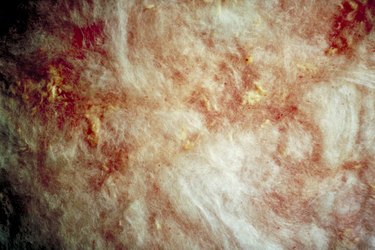
Discolored, dirty insulation is a sign of mold growth or an air leak. These problems are commonly found in batt insulation used in walls, basements and attics. Dirty insulation resulting from an air leak is not a problem, however it is a symptom of other issues in your home. Mold growing in your insulation usually results from condensation or a plumbing leak.
Air Leaks
Video of the Day
Gaps in the structure around your insulation will suck air through your insulation. As air is pulled through the insulation, dust and dirt suspended in the air will lodge in your insulation. Over time the accumulating dirt will darken your insulation in the areas surrounding the air leaks. This dirt will not affect the performance of your insulation although it will provide nutrients that can allow mold to grow if your insulation gets wet.
Video of the Day
Mold
Mold growing in your insulation will discolor it and can pose a serious health threat. Mold commonly grows inside walls, above ceilings and underneath floors where leaks or condensation provide a source of moisture. If your insulation is moldy, you should remove it while taking precautions to protect yourself. After removing the contaminated insulation, locate and eliminate the source of the moisture before replacing the insulation. Dispose of moldy insulation in doubled trash bags sealed with tape, and use a face mask, eye protection and gloves when handling moldy insulation.
Fixing The Problem
Air leaks in the home are a source of energy loss and can cause the warm moist air from your home to condense on fixtures or beams outside your insulation during cold weather. The space around fixtures, recessed lights, plumbing pipes, electrical conduit and air ducts are common areas where air can infiltrate through your insulation. Apply spray foam insulation into most small gaps to seal air leaks around fixtures. Larger gaps will require a piece of foam insulation board cut to fit the gap and sealed around the edges using caulk or spray foam. Sealing these gaps will improve energy efficiency and help prevent mold from growing in your insulation.
Considerations
Air leaks in the basement of your home can create a chimney effect that will force air out of your home and into your attic. Discolored insulation in the attic near the outer walls of your home is often a sign of an air leak in the basement. You can add insulation above your exterior walls in the attic to prevent air from flowing up through your home and escaping through your attic. High humidity in your home can also cause mold to grow. If you find mold growing in your insulation above a bathroom, kitchen or other areas where water is used, consider installing a dehumidifier or reducing your water use to lower the humidity in your home.